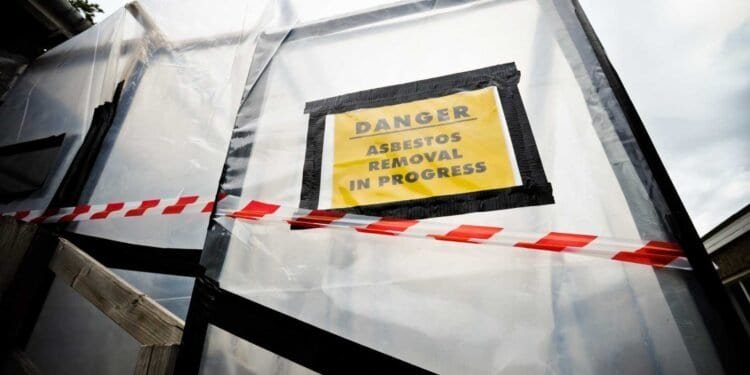Asbestos is a naturally occurring mineral that was once widely used in construction and manufacturing due to its heat-resistant properties. However, it was later discovered that asbestos exposure can lead to serious health risks such as lung cancer, mesothelioma, and asbestosis. As a result, the use of asbestos has been heavily regulated by government agencies such as the Environmental Protection Agency (EPA) and the World Health Organization (WHO).

Despite these regulations, asbestos can still be found in unexpected places in our everyday lives. For example, asbestos can be found in household appliances such as hair dryers, crockpots, and toasters. It can also be found in automotive parts such as brake pads and gaskets. Even schools and other public buildings may contain asbestos in their building materials, putting occupants at risk of exposure.
Given the health implications of asbestos exposure, it is important to be aware of unexpected sources of asbestos in our daily lives. By understanding where asbestos can be found, individuals can take steps to minimize their exposure and protect their health.
Key Takeaways
- Asbestos is a naturally occurring mineral that was once widely used in construction and manufacturing but has since been heavily regulated due to its health risks.
- Asbestos can still be found in unexpected places in our everyday lives such as household appliances, automotive parts, and building materials.
- It is important to be aware of unexpected sources of asbestos and take steps to minimize exposure to protect one’s health.
What is Asbestos?

Asbestos is a naturally occurring mineral that is made up of flexible fibers. These fibers are resistant to heat, electricity, and chemical corrosion, which makes asbestos a popular material for use in a variety of industrial and construction applications.
Types of Asbestos
There are several types of asbestos, including chrysotile, amphibole asbestos (which includes actinolite, anthophyllite, crocidolite, and amosite), and tremolite. Chrysotile is the most commonly used type of asbestos and is often found in building materials such as ceiling tiles, roofing shingles, and insulation. Amphibole asbestos, on the other hand, is less common and is found in products such as fireproofing materials and pipe insulation.
Historical Use of Asbestos
Asbestos has been used for centuries, and its use became widespread during the industrial revolution. In the early 1900s, asbestos was used in everything from insulation and fireproofing materials to brake pads and gaskets. It wasn’t until the 1970s that the dangers of asbestos exposure became widely known, and its use began to be regulated.
Today, the use of asbestos is heavily regulated in many countries, including the United States. However, asbestos can still be found in many older buildings and products, and exposure to asbestos fibers can lead to serious health problems, including lung cancer, mesothelioma, and asbestosis.
In conclusion, asbestos is a naturally occurring mineral that has been used for centuries in a variety of industrial and construction applications. While its use is heavily regulated today, it can still be found in many older buildings and products. It is important to take precautions to avoid exposure to asbestos fibers, as they can lead to serious health problems.
Health Implications of Asbestos Exposure

Asbestos is a naturally occurring mineral that was widely used in the past due to its heat-resistant properties. However, it is now known to be a carcinogen, and exposure to asbestos fibers can lead to serious health risks, including cancer and lung disease.
Asbestos-Related Diseases
Exposure to asbestos can cause a variety of diseases, including asbestosis, lung cancer, and malignant mesothelioma. Asbestosis is a chronic lung disease that results from the inhalation of asbestos fibers, causing scarring of the lung tissue. Symptoms of asbestosis include shortness of breath, coughing, and chest pain. Lung cancer is another potential consequence of asbestos exposure, and it is often fatal. Malignant mesothelioma is a rare and aggressive cancer that affects the lining of the lungs, abdomen, or heart. It can take years or even decades for symptoms of these diseases to appear after exposure to asbestos.
Risk Factors for Asbestos Diseases
The risk of developing an asbestos-related disease depends on several factors, including the duration and intensity of exposure, the type of asbestos fibers inhaled, and individual risk factors such as smoking. Those who have been exposed to asbestos in the workplace, particularly in jobs such as construction, shipbuilding, and manufacturing, are at higher risk for developing asbestos-related diseases. However, exposure to asbestos can also occur in unexpected places, such as in homes and schools built before the 1980s, where asbestos-containing materials may have been used in construction.
In conclusion, the health risks associated with asbestos exposure are serious and can lead to life-threatening diseases. It is important to take precautions to avoid exposure to asbestos fibers, particularly in high-risk occupations and older buildings. If you suspect that you may have been exposed to asbestos, it is important to speak with a healthcare professional and get screened for potential health problems.
Asbestos in Building Materials

Asbestos was commonly used in building materials prior to the 1980s due to its heat-resistant properties and durability. As a result, many older homes and buildings may still contain asbestos in various forms. It is important to identify and properly handle any asbestos-containing materials to avoid health risks associated with exposure to asbestos fibers.
Identifying Asbestos in Homes
Asbestos can be found in a variety of building materials, including insulation, cement, floor tiles, roofing, and drywall. It is important to note that asbestos-containing materials are not always easy to identify, as they may be mixed with other materials or covered by layers of paint or other finishes.
One way to identify potential asbestos-containing materials is to hire a professional asbestos inspector to conduct an inspection of the building. Another option is to use a testing kit to collect samples of suspected materials and send them to a laboratory for analysis.
Asbestos in Commercial Buildings
Asbestos-containing materials were also commonly used in commercial buildings, such as schools, hospitals, and office buildings. In these settings, asbestos may be found in insulation, ceiling tiles, floor tiles, and other building materials.
If asbestos-containing materials are identified in a commercial building, it is important to follow proper procedures for removal and disposal to ensure the safety of workers and occupants. This may involve sealing off the area, using protective equipment, and following specific guidelines for the removal and disposal of asbestos-containing materials.
Overall, it is important to be aware of the potential presence of asbestos in building materials and to take appropriate steps to identify and handle any asbestos-containing materials in a safe and responsible manner.
Unexpected Sources of Asbestos
Asbestos is a naturally occurring mineral that was once widely used in construction, automotive, and manufacturing industries due to its heat-resistant properties. Despite the known health risks associated with asbestos exposure, it can still be found in many unexpected places in our everyday lives. This section highlights two of the most common unexpected sources of asbestos: household products and soil contamination.
Household Products Containing Asbestos
Many older household products were manufactured using asbestos-containing materials. These products include hairdryers, crockpots, and other small appliances that were once insulated with asbestos. Exposure to asbestos fibers from these products can occur when the insulation becomes damaged or worn, releasing the fibers into the air. It is recommended to replace these older appliances with newer ones that do not contain asbestos.
Asbestos Contamination in Soil
Asbestos fibers can also be found in soil, particularly in areas near asbestos mines or industrial sites. Soil contamination can occur when asbestos-containing materials are improperly disposed of, or when buildings containing asbestos materials are demolished. Asbestos fibers in soil can become airborne during excavation or other activities that disturb the soil, leading to potential exposure. It is important to take precautions when working with soil in areas where asbestos contamination is suspected, such as wearing protective clothing and using proper ventilation.
While asbestos use has declined in recent years, it is still important to be aware of the potential sources of asbestos in our everyday lives. By taking precautions and being informed, we can reduce our risk of exposure and protect our health.
Occupational Asbestos Exposure

Asbestos exposure is a significant health risk that can lead to mesothelioma, lung cancer, and other respiratory diseases. While asbestos use has been banned in many countries, it is still present in many older buildings, products, and materials. One of the most common ways people are exposed to asbestos is through their occupation.
High-Risk Occupations
Many occupations put workers at risk of asbestos exposure, including construction workers, firefighters, shipbuilders, and industrial workers. These workers may come into contact with asbestos-containing materials such as insulation, gaskets, and brake pads. According to a study by the National Institute for Occupational Safety and Health (NIOSH), nearly 1.3 million construction workers are exposed to asbestos each year in the United States alone.
Safety Regulations and Measures
To protect workers from occupational asbestos exposure, many countries have established safety regulations and measures. For example, the Occupational Safety and Health Administration (OSHA) in the United States has established standards for asbestos exposure in the workplace. These standards include monitoring and testing for asbestos, providing protective equipment and clothing, and training workers on how to work safely around asbestos-containing materials.
Employers are also required to provide medical examinations for workers who may have been exposed to asbestos. These examinations can help identify any health problems related to asbestos exposure, such as lung cancer or mesothelioma, at an early stage when they may be more treatable.
Overall, it is important for workers to be aware of the risks of occupational asbestos exposure and to take appropriate safety measures to protect themselves. By following safety regulations and measures, workers can reduce their risk of asbestos-related diseases and stay healthy and safe on the job.
Asbestos Abatement and Legal Issues
Asbestos Removal Procedures
Asbestos removal procedures are critical to ensure that asbestos-containing materials (ACMs) are safely removed from buildings and structures. When asbestos is disturbed, it can release fibers into the air, which can be inhaled and cause serious health problems such as mesothelioma. Therefore, it is important to have professionals handle asbestos removal to prevent exposure to this hazardous material.
The Environmental Protection Agency (EPA) provides guidelines for asbestos removal procedures to ensure that asbestos is handled safely and effectively. These guidelines include wetting down ACMs to prevent the release of fibers, using protective equipment, and proper disposal of asbestos waste.
Asbestos Legislation
There are several laws and regulations related to asbestos that have been put in place to protect the public from exposure to this hazardous material. The Clean Air Act (CAA) is one of the most important laws related to asbestos. It regulates the emission of asbestos fibers into the air and sets standards for the handling, removal, and disposal of asbestos-containing materials.
In addition to the CAA, there are also state and local regulations that govern the handling and removal of asbestos. These regulations may vary depending on the location and type of building or structure being worked on.
Asbestos-related legal issues can be complex and may involve multiple parties, including building owners, contractors, and insurance companies. If you suspect that you have been exposed to asbestos or have been diagnosed with mesothelioma, it is important to seek legal advice from an experienced attorney.
Overall, it is important to take asbestos abatement and legal issues seriously to protect yourself and others from the harmful effects of asbestos exposure.
Future of Asbestos Use and Regulation

Advancements in Asbestos Detection
Asbestos is a dangerous mineral that can cause cancer and other serious health problems. Despite being banned in many countries, asbestos is still used in some industries and products. However, advancements in asbestos detection are making it easier to identify and remove asbestos from buildings and products.
One such advancement is the use of electron microscopy to detect asbestos fibers in air samples and materials. This technique can detect very small amounts of asbestos and is more accurate than older methods. Another technique is the use of X-ray diffraction to identify asbestos minerals in materials. These methods are helping to improve the accuracy of asbestos testing and reduce the risk of exposure.
Global Asbestos Policies
The use of asbestos is regulated by governments around the world. The World Health Organization (WHO) has called for a global ban on asbestos, citing the health risks associated with exposure. Many countries have already banned or restricted the use of asbestos, including the European Union, Australia, and Japan.
In the United States, the Environmental Protection Agency (EPA) regulates the use of asbestos under the Toxic Substances Control Act (TSCA). The EPA has proposed new rules to strengthen asbestos regulation, including requiring more comprehensive reporting on asbestos use and exposure. The agency is also conducting risk evaluations of asbestos to determine if further action is needed to protect public health.
The mining of asbestos has also been a topic of concern. Asbestos mining has been banned in many countries due to the health risks associated with exposure. The WHO has called for a global ban on asbestos mining and the use of asbestos in new products.
Overall, the future of asbestos use and regulation is moving towards stricter rules and regulations to protect public health. While asbestos is still present in some products and buildings, advancements in detection and regulations are making it easier to identify and remove asbestos from our everyday lives.
Frequently Asked Questions

What common household items may contain asbestos?
Asbestos was commonly used in building materials during the 20th century, and many of these materials are still present in homes today. Common household items that may contain asbestos include insulation, roofing and flooring materials, and textured paint. Asbestos may also be present in older appliances, such as hairdryers and crock pots, and in power cords that were coated with an asbestos sheath to prevent electrical fires [1].
In which modern products might asbestos still be found?
Asbestos is still used in some products today, but its use is heavily regulated. Some modern products that may contain asbestos include brake pads, roofing materials, and insulation. However, these products are typically labeled as containing asbestos, and workers who handle them are required to take precautions to prevent exposure [2].
How can asbestos be present in fireproofing materials used in homes?
Asbestos was commonly used in fireproofing materials, such as spray-on insulation and fireproofing coatings. These materials were often used in commercial and public buildings, but may also be present in homes built before the 1980s. Asbestos-containing fireproofing materials can release fibers into the air if they are damaged or disturbed, which can pose a health risk to occupants [2].
Can light fixtures in homes contain asbestos, and if so, how?
Some older light fixtures may contain asbestos, particularly those that were manufactured before the 1980s. Asbestos was sometimes used in the backing of light fixtures, as well as in the wiring insulation. If these materials become damaged or disturbed, they can release asbestos fibers into the air [1].
What practices in mobile home manufacturing historically involved asbestos?
Mobile homes that were manufactured before the 1980s often contained asbestos in insulation, flooring, and other building materials. Workers who manufactured these homes were often exposed to asbestos fibers during the manufacturing process. As a result, mobile home manufacturing is considered a high-risk occupation for asbestos exposure [3].
What are the typical environmental sources of asbestos exposure?
Asbestos is a naturally occurring mineral that can be found in soil and rocks. People who live near asbestos mines or processing facilities may be exposed to higher levels of asbestos in the environment. Asbestos fibers can also be released into the air during natural disasters, such as wildfires and tornadoes, which can pose a health risk to nearby residents [4].














